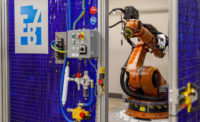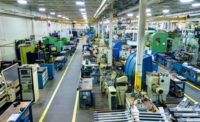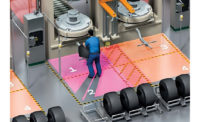One organization that is putting a dent in those statistics is The Lighthouse for the Blind Inc., an AS9100- and ISO 2001:9000-certified manufacturer that provides advanced machining, fabrication and assembly services. Located in Seattle, the Lighthouse handles both low- and high-volume orders. Its customers include federal defense organizations, such as the Army and Navy, in addition to aerospace and commercial manufacturers.
A nonprofit organization, the Lighthouse has been providing machine shop services for more than 60 years. It employs more than 230 blind or deaf-blind workers—80 percent of its workforce—including 70 machinists who are blind or deaf-blind. Each month, these employees create more than 5,500 unique parts at a total volume of 50,000 pieces for Boeing and other aerospace companies with an acceptance rate of more than 99.96 percent.
The workforce at Lighthouse turns out a wide variety of parts and equipment, including aerospace components, specialty tools, office products, hydration packs, bulletin boards, mops and canteens.
Workers do their jobs with help of sophisticated assistive technologies, including large-print keyboards, computer screen-reading software known as JAWS (Job Access With Speech), and digital calipers paired with a voice output device that speaks the measurement on the readout.
With these aids, blind and deaf-blind personnel can operate the most up-to-date equipment for producing aircraft parts and other products with the same skill as sighted individuals.
The Lighthouse manufacturing facility specializes in:
- brake forming.
- conventional and CNC turning and milling.
- conventional and CNC shearing.
- hydroform manufacturing.
- injection molding.
- metal fabrication and riveting.
- nonmetallic machining.
- radio frequency sealing and welding.
- subassembly and final assembly.
- stamping.
-
water-jet cutting.
Adding Robotics
One key to the company’s success has been its investment in advanced technology. For example, Lighthouse recently deployed a robotic finishing cell. The cell has become an integral part of the manufacturing and assembly process for the company’s E-Tool, a collapsible shovel used by members of the U.S. military as well as relief agencies. Because the tool is often used in hostile environments, its efficiency and reliability are paramount.
The cell was designed, built, and installed by PRE-TEC, a systems integrator specializing in robotics.
Intended to be operated entirely by blind workers, the cell is built around a six-axis robot from FANUC Robotics America Corp. The robot has sensors that detect when a cart full of shovel blades, which have been loaded by blind workers, is ready for processing. Once the cart is locked into the cell, the robot selects a blade from the cart and takes it completely through a four-step grinding and finishing process. The robot then loads the blade into a second cart. When full, the cart is transported to the assembly workstation.
“Performed by hand, putting the edge on the blades is a hot, laborious and slightly dangerous process,” says Douglas Hintz, special projects coordinator for The Lighthouse for the Blind. “Grinding a perfect edge on D150 spring steel, then cleaning the sharpened blade, requires considerable care. It is a slow and labor-intensive process when done conventionally, and we needed a quicker, more efficient and safer process that our workforce could easily handle.
“The robotic finishing cell improves throughput and quality and contributes to overall cost containment, while being very user-friendly for our employees, all of whom are vision-impaired or otherwise physically challenged,” explains Hintz. “PRE-TEC provided a robotic finishing cell with audio and enhanced visual monitors that ensure that our associates maintain productivity and top quality in the grinding, finishing and inspection stages of production. This assures that good parts can be put together in assembly, and more importantly, they won’t fail when being used by people in the field.”
A key piece of equipment in the cell is FANUC’s iRVision, a plug-and-go vision system that runs on the standard CPU of every FANUC controller without any additional hardware. “This system basically replaces human vision in error proofing, visual tracking and quality control,” says James Farmer, account manager at FANUC Robotics. “The system at Lighthouse verifies that the shovel blade is ready to go through the finishing process. It verifies that the mounting holes are in location and within tolerance, more accurately than human inspection.”
“We have built a reputation for manufacturing and assembling well-made, sought-after equipment and products, delivered on time,” says Hintz. “The new robotic cell helps ensure that the E-Tool is no different from anything else we make. The robot cell helps us...achieve our profitability goals,” Hintz says.
Detailed Assembly Procedures
The Lighthouse stresses adherence to Boeing’s assembly procedures throughout its operations. The organization also provides each employee with extensive training and workplace accommodations.
“Our philosophy requires that each employee be provided with whatever supports are necessary for success in the workplace,” says Hintz. “To make this happen, Lighthouse provides a comprehensive range of training programs and career development opportunities.”
Training includes:
- braille literacy.
- computer skills.
- orientation and mobility.
- interpreting services.
- supported employment.
- housing support.
Lighthouse employs blind or deaf-blind personnel throughout the organization, including project management, human resources, information technology, and finance. In fact, Lighthouse’s president and CEO, Kirk Adams, has been fully blind since he was 5 years old.
“It was rewarding for PRE-TEC to provide a state-of-the-art manufacturing cell that helps produce sophisticated, in-demand products and maintains productivity while meeting the needs of Lighthouse employees,” notes Rufus Burton, sales manager for PRE-TEC.
PRE-TEC designs flexible automated systems for a variety of manufacturing and assembly applications, including finish-ing, material handling and welding. PRE-TEC’s systems include six-axis robots, custom-built end-of-arm tools and convey-ors.
Based in Eugene, OR, PRE-TEC was founded nearly 30 years ago when its corporate parent, Willamette Valley Co., needed a reliable sophisticated system for metering chemical products. When a suitable supplier could not be found, PRE-TEC was formed to produce the system as well as offer engineering and integration services. Since then, PRE-TEC has engineered more than 165 robotic systems for a wide range of industries and products.
For more information on robotic workcells, call PRE-TEC at 800-205-9826 or visit www.pre-tec.com.
For more information on robots, call FANUC at 800-477-6268 or visit www.fanucrobotics.com.
For more information on products made by The Lighthouse for the Blind or for information on training or accommodating blind workers, call 800-914-7307 or visit http://seattlelighthouse.com.







